Operations Research Project: Assortment Planning with CTMC Modeling
VerifiedAdded on 2022/11/28
|18
|5073
|161
Project
AI Summary
This project focuses on modeling and optimizing the multi-product assortment optimization problem with substitutable demand using a Continuous-Time Markov Chain (CTMC) or Queuing model. The assignment explores the concept of assortment planning, which involves determining the optimal set of items available in a retail setting to maximize sales or gross margin. The project is divided into phases, beginning with a literature review to define the problem and understand the factors influencing assortment planning, such as seasonal variations, new product introductions, and consumer preferences. The study then delves into the estimation of parameters for optimal strategy development and discusses various optimization approaches for assortment plans. It covers the differences between static and dynamic assortment planning, the characteristics of a good assortment, and the pros and cons of assortment depth and breadth. Finally, the project examines the store policies related to merchandise assortment planning and the product life cycle, which impact assortment decisions. The goal is to provide a comprehensive understanding of the key elements involved in effective assortment planning and optimization within a retail environment.
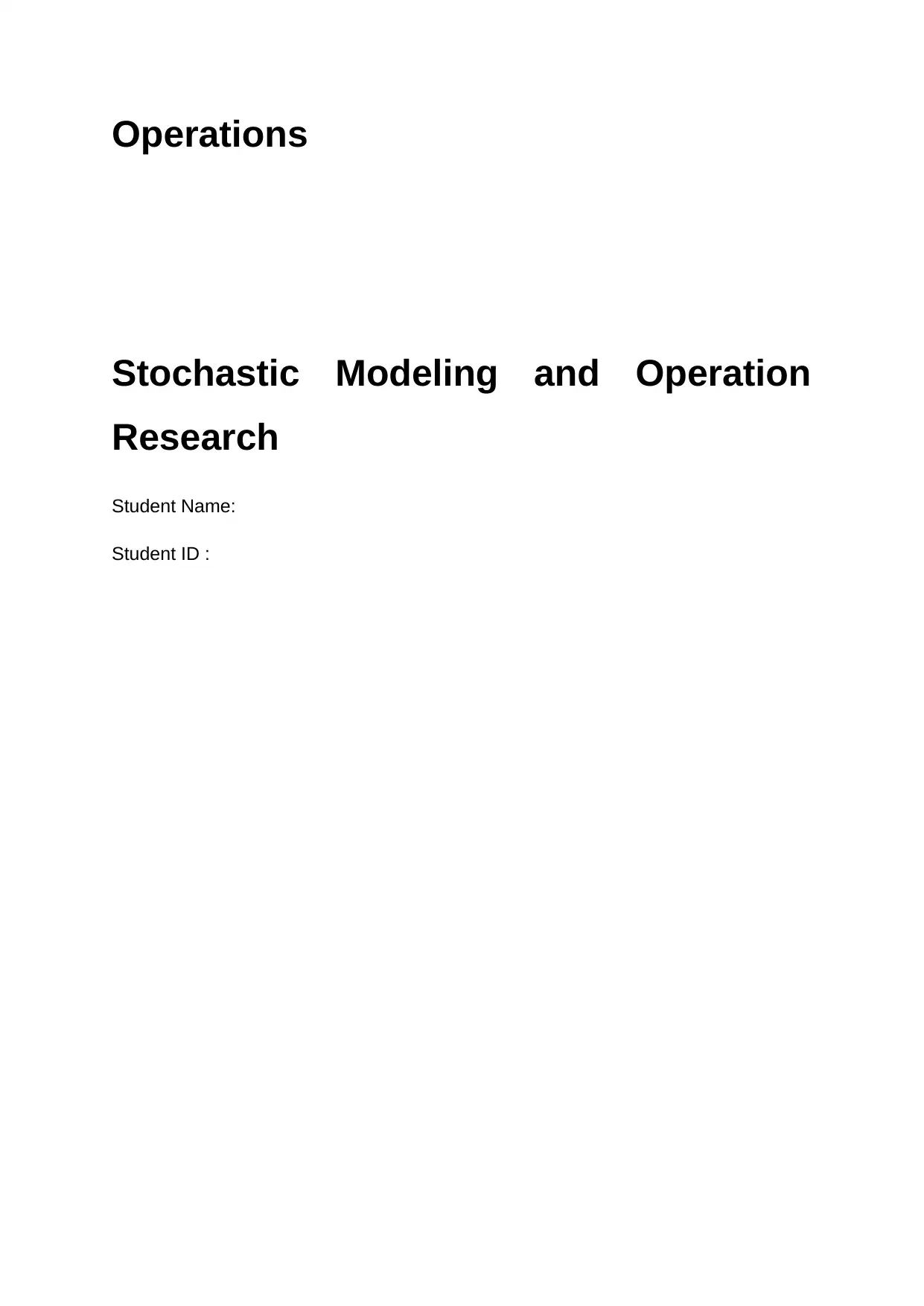
Operations
Stochastic Modeling and Operation
Research
Student Name:
Student ID :
Stochastic Modeling and Operation
Research
Student Name:
Student ID :
Paraphrase This Document
Need a fresh take? Get an instant paraphrase of this document with our AI Paraphraser
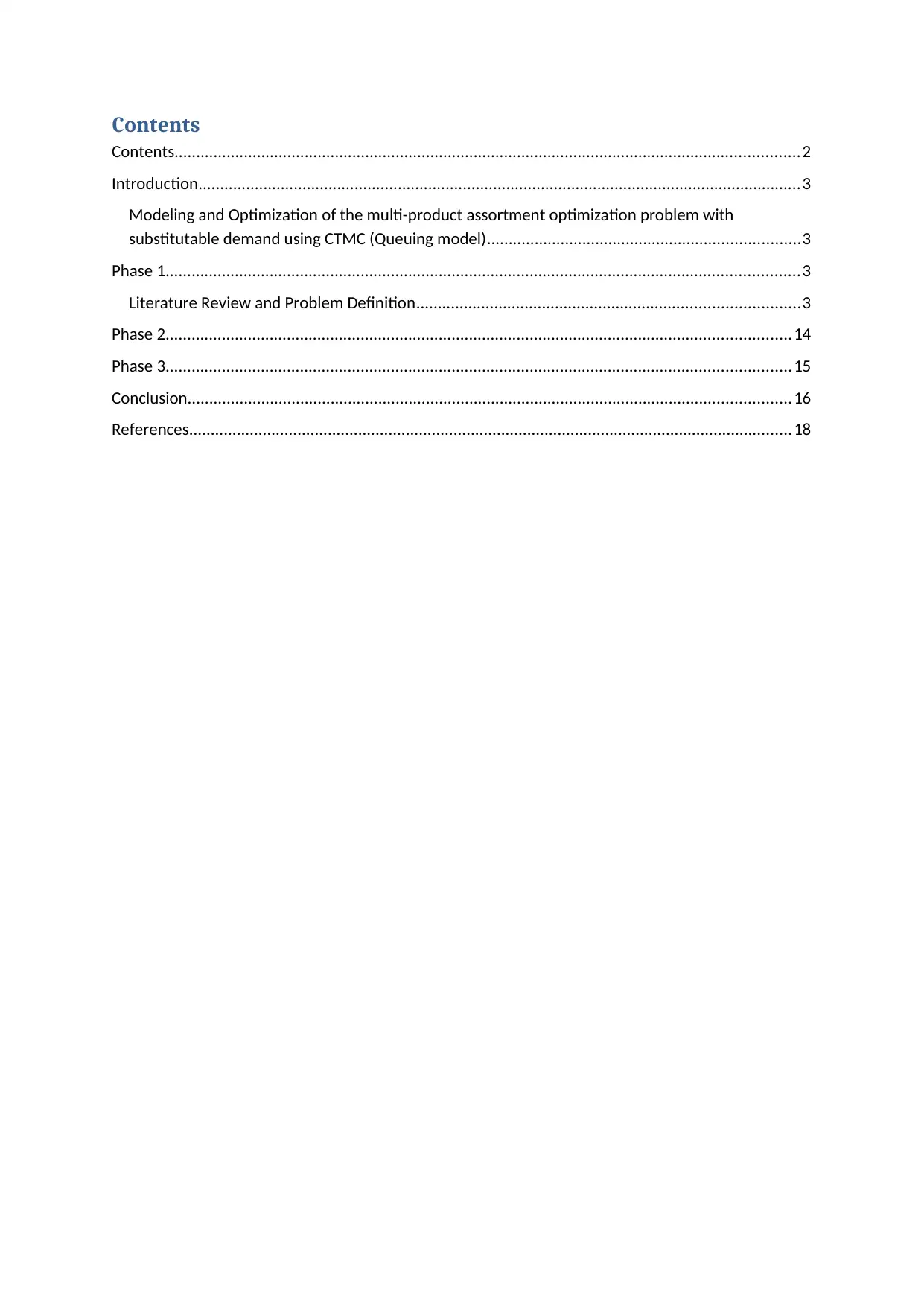
Contents
Contents................................................................................................................................................2
Introduction...........................................................................................................................................3
Modeling and Optimization of the multi-product assortment optimization problem with
substitutable demand using CTMC (Queuing model)........................................................................3
Phase 1..................................................................................................................................................3
Literature Review and Problem Definition........................................................................................3
Phase 2................................................................................................................................................14
Phase 3................................................................................................................................................15
Conclusion...........................................................................................................................................16
References...........................................................................................................................................18
Contents................................................................................................................................................2
Introduction...........................................................................................................................................3
Modeling and Optimization of the multi-product assortment optimization problem with
substitutable demand using CTMC (Queuing model)........................................................................3
Phase 1..................................................................................................................................................3
Literature Review and Problem Definition........................................................................................3
Phase 2................................................................................................................................................14
Phase 3................................................................................................................................................15
Conclusion...........................................................................................................................................16
References...........................................................................................................................................18
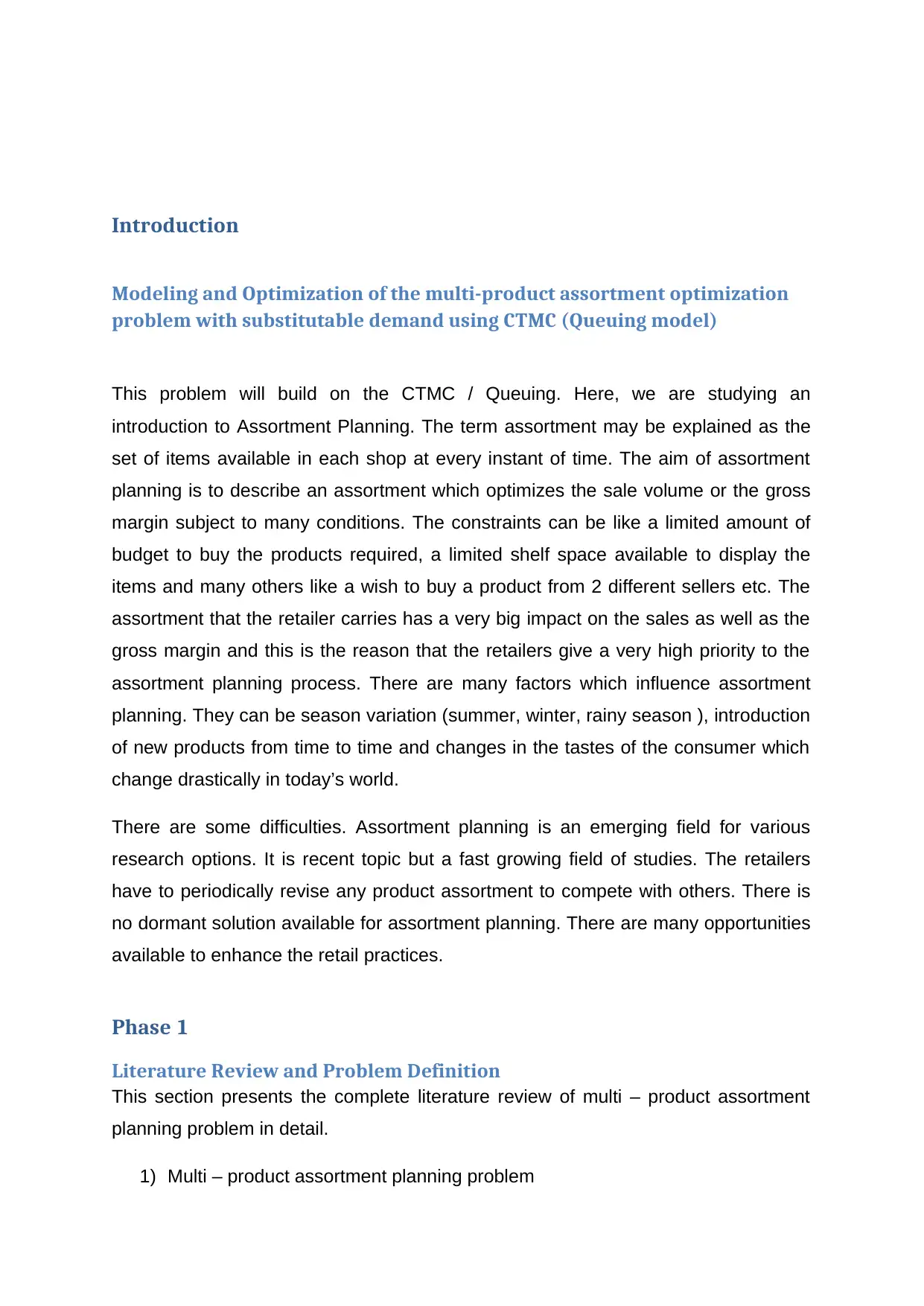
Introduction
Modeling and Optimization of the multi-product assortment optimization
problem with substitutable demand using CTMC (Queuing model)
This problem will build on the CTMC / Queuing. Here, we are studying an
introduction to Assortment Planning. The term assortment may be explained as the
set of items available in each shop at every instant of time. The aim of assortment
planning is to describe an assortment which optimizes the sale volume or the gross
margin subject to many conditions. The constraints can be like a limited amount of
budget to buy the products required, a limited shelf space available to display the
items and many others like a wish to buy a product from 2 different sellers etc. The
assortment that the retailer carries has a very big impact on the sales as well as the
gross margin and this is the reason that the retailers give a very high priority to the
assortment planning process. There are many factors which influence assortment
planning. They can be season variation (summer, winter, rainy season ), introduction
of new products from time to time and changes in the tastes of the consumer which
change drastically in today’s world.
There are some difficulties. Assortment planning is an emerging field for various
research options. It is recent topic but a fast growing field of studies. The retailers
have to periodically revise any product assortment to compete with others. There is
no dormant solution available for assortment planning. There are many opportunities
available to enhance the retail practices.
Phase 1
Literature Review and Problem Definition
This section presents the complete literature review of multi – product assortment
planning problem in detail.
1) Multi – product assortment planning problem
Modeling and Optimization of the multi-product assortment optimization
problem with substitutable demand using CTMC (Queuing model)
This problem will build on the CTMC / Queuing. Here, we are studying an
introduction to Assortment Planning. The term assortment may be explained as the
set of items available in each shop at every instant of time. The aim of assortment
planning is to describe an assortment which optimizes the sale volume or the gross
margin subject to many conditions. The constraints can be like a limited amount of
budget to buy the products required, a limited shelf space available to display the
items and many others like a wish to buy a product from 2 different sellers etc. The
assortment that the retailer carries has a very big impact on the sales as well as the
gross margin and this is the reason that the retailers give a very high priority to the
assortment planning process. There are many factors which influence assortment
planning. They can be season variation (summer, winter, rainy season ), introduction
of new products from time to time and changes in the tastes of the consumer which
change drastically in today’s world.
There are some difficulties. Assortment planning is an emerging field for various
research options. It is recent topic but a fast growing field of studies. The retailers
have to periodically revise any product assortment to compete with others. There is
no dormant solution available for assortment planning. There are many opportunities
available to enhance the retail practices.
Phase 1
Literature Review and Problem Definition
This section presents the complete literature review of multi – product assortment
planning problem in detail.
1) Multi – product assortment planning problem
⊘ This is a preview!⊘
Do you want full access?
Subscribe today to unlock all pages.

Trusted by 1+ million students worldwide
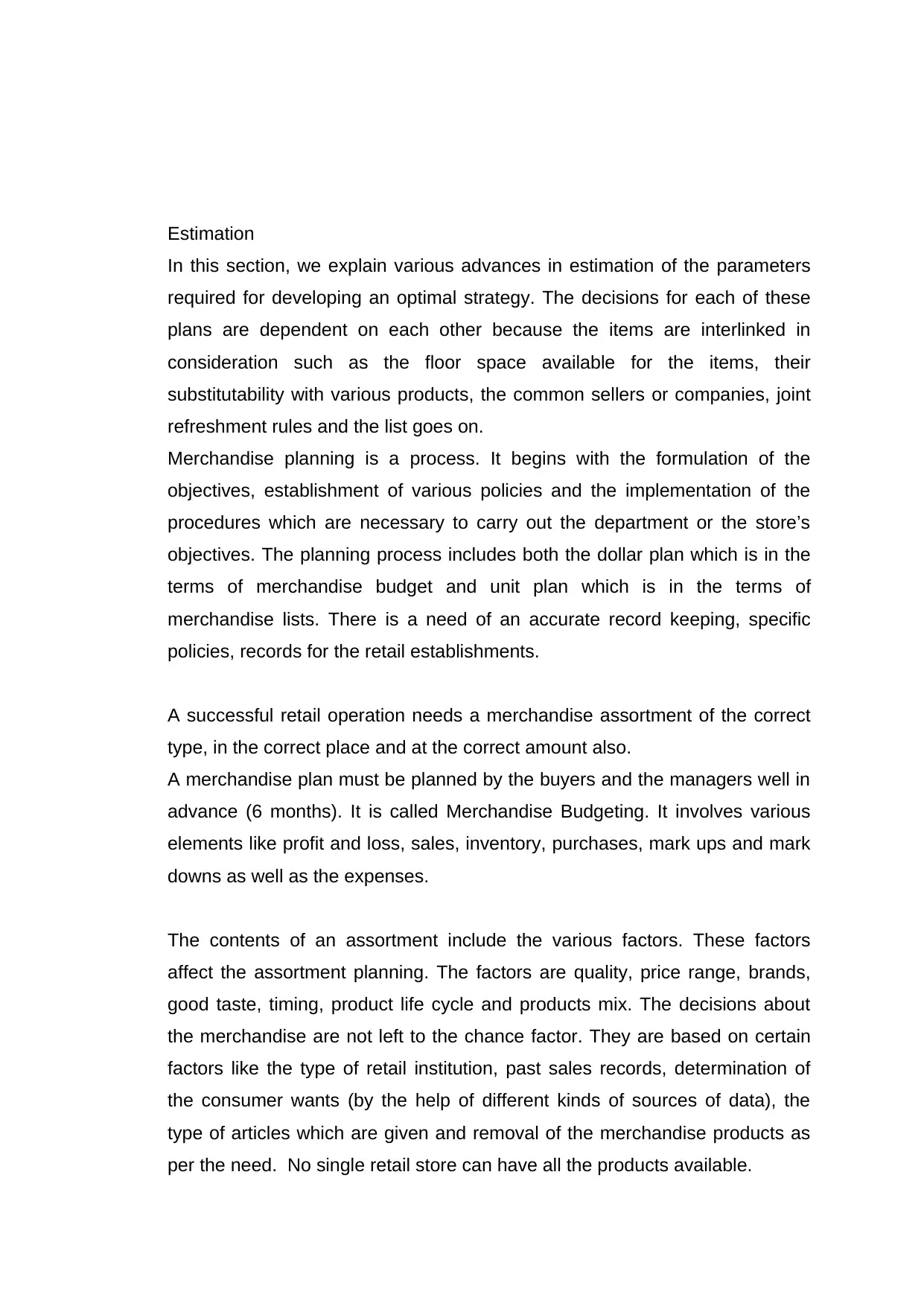
Estimation
In this section, we explain various advances in estimation of the parameters
required for developing an optimal strategy. The decisions for each of these
plans are dependent on each other because the items are interlinked in
consideration such as the floor space available for the items, their
substitutability with various products, the common sellers or companies, joint
refreshment rules and the list goes on.
Merchandise planning is a process. It begins with the formulation of the
objectives, establishment of various policies and the implementation of the
procedures which are necessary to carry out the department or the store’s
objectives. The planning process includes both the dollar plan which is in the
terms of merchandise budget and unit plan which is in the terms of
merchandise lists. There is a need of an accurate record keeping, specific
policies, records for the retail establishments.
A successful retail operation needs a merchandise assortment of the correct
type, in the correct place and at the correct amount also.
A merchandise plan must be planned by the buyers and the managers well in
advance (6 months). It is called Merchandise Budgeting. It involves various
elements like profit and loss, sales, inventory, purchases, mark ups and mark
downs as well as the expenses.
The contents of an assortment include the various factors. These factors
affect the assortment planning. The factors are quality, price range, brands,
good taste, timing, product life cycle and products mix. The decisions about
the merchandise are not left to the chance factor. They are based on certain
factors like the type of retail institution, past sales records, determination of
the consumer wants (by the help of different kinds of sources of data), the
type of articles which are given and removal of the merchandise products as
per the need. No single retail store can have all the products available.
In this section, we explain various advances in estimation of the parameters
required for developing an optimal strategy. The decisions for each of these
plans are dependent on each other because the items are interlinked in
consideration such as the floor space available for the items, their
substitutability with various products, the common sellers or companies, joint
refreshment rules and the list goes on.
Merchandise planning is a process. It begins with the formulation of the
objectives, establishment of various policies and the implementation of the
procedures which are necessary to carry out the department or the store’s
objectives. The planning process includes both the dollar plan which is in the
terms of merchandise budget and unit plan which is in the terms of
merchandise lists. There is a need of an accurate record keeping, specific
policies, records for the retail establishments.
A successful retail operation needs a merchandise assortment of the correct
type, in the correct place and at the correct amount also.
A merchandise plan must be planned by the buyers and the managers well in
advance (6 months). It is called Merchandise Budgeting. It involves various
elements like profit and loss, sales, inventory, purchases, mark ups and mark
downs as well as the expenses.
The contents of an assortment include the various factors. These factors
affect the assortment planning. The factors are quality, price range, brands,
good taste, timing, product life cycle and products mix. The decisions about
the merchandise are not left to the chance factor. They are based on certain
factors like the type of retail institution, past sales records, determination of
the consumer wants (by the help of different kinds of sources of data), the
type of articles which are given and removal of the merchandise products as
per the need. No single retail store can have all the products available.
Paraphrase This Document
Need a fresh take? Get an instant paraphrase of this document with our AI Paraphraser
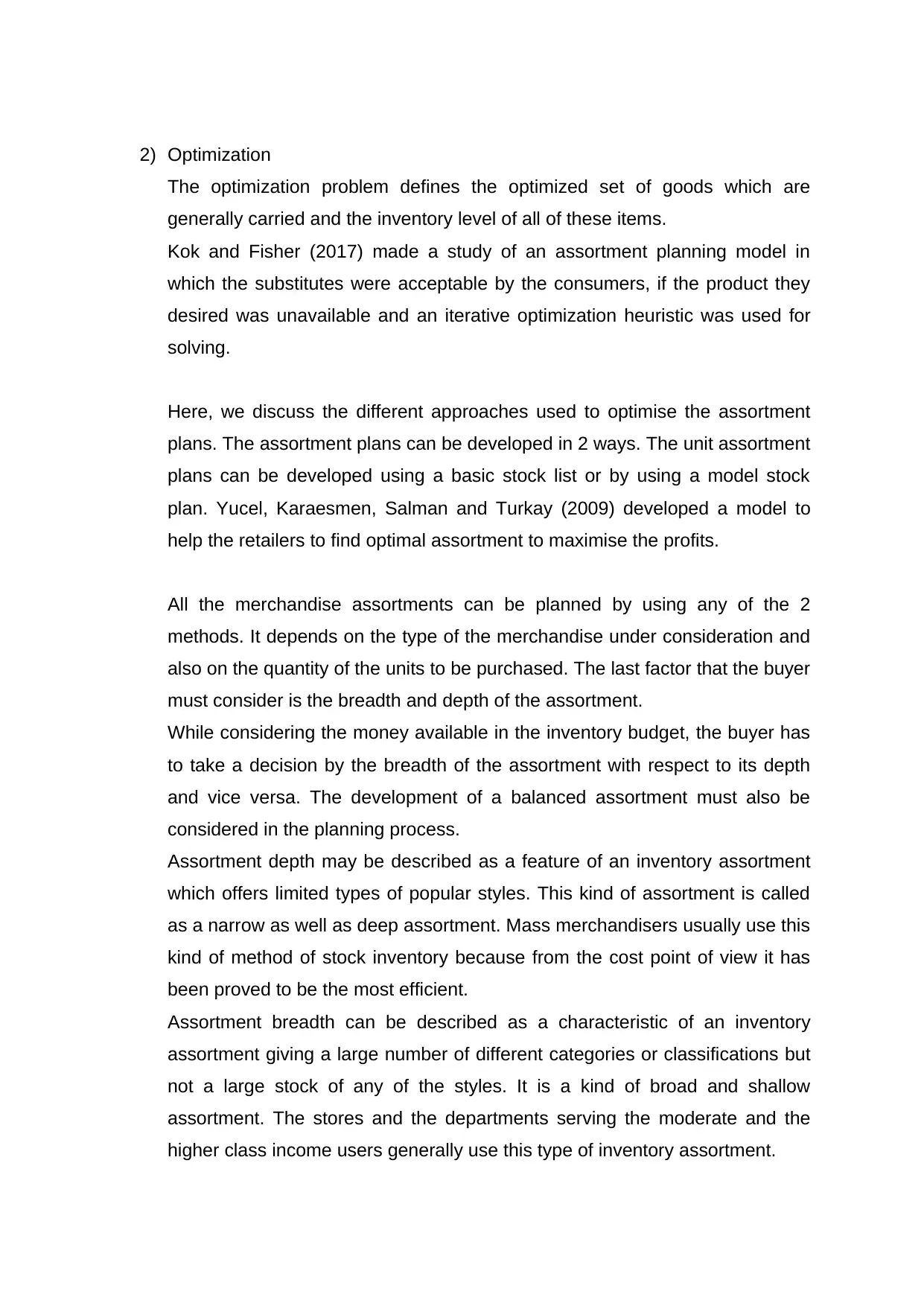
2) Optimization
The optimization problem defines the optimized set of goods which are
generally carried and the inventory level of all of these items.
Kok and Fisher (2017) made a study of an assortment planning model in
which the substitutes were acceptable by the consumers, if the product they
desired was unavailable and an iterative optimization heuristic was used for
solving.
Here, we discuss the different approaches used to optimise the assortment
plans. The assortment plans can be developed in 2 ways. The unit assortment
plans can be developed using a basic stock list or by using a model stock
plan. Yucel, Karaesmen, Salman and Turkay (2009) developed a model to
help the retailers to find optimal assortment to maximise the profits.
All the merchandise assortments can be planned by using any of the 2
methods. It depends on the type of the merchandise under consideration and
also on the quantity of the units to be purchased. The last factor that the buyer
must consider is the breadth and depth of the assortment.
While considering the money available in the inventory budget, the buyer has
to take a decision by the breadth of the assortment with respect to its depth
and vice versa. The development of a balanced assortment must also be
considered in the planning process.
Assortment depth may be described as a feature of an inventory assortment
which offers limited types of popular styles. This kind of assortment is called
as a narrow as well as deep assortment. Mass merchandisers usually use this
kind of method of stock inventory because from the cost point of view it has
been proved to be the most efficient.
Assortment breadth can be described as a characteristic of an inventory
assortment giving a large number of different categories or classifications but
not a large stock of any of the styles. It is a kind of broad and shallow
assortment. The stores and the departments serving the moderate and the
higher class income users generally use this type of inventory assortment.
The optimization problem defines the optimized set of goods which are
generally carried and the inventory level of all of these items.
Kok and Fisher (2017) made a study of an assortment planning model in
which the substitutes were acceptable by the consumers, if the product they
desired was unavailable and an iterative optimization heuristic was used for
solving.
Here, we discuss the different approaches used to optimise the assortment
plans. The assortment plans can be developed in 2 ways. The unit assortment
plans can be developed using a basic stock list or by using a model stock
plan. Yucel, Karaesmen, Salman and Turkay (2009) developed a model to
help the retailers to find optimal assortment to maximise the profits.
All the merchandise assortments can be planned by using any of the 2
methods. It depends on the type of the merchandise under consideration and
also on the quantity of the units to be purchased. The last factor that the buyer
must consider is the breadth and depth of the assortment.
While considering the money available in the inventory budget, the buyer has
to take a decision by the breadth of the assortment with respect to its depth
and vice versa. The development of a balanced assortment must also be
considered in the planning process.
Assortment depth may be described as a feature of an inventory assortment
which offers limited types of popular styles. This kind of assortment is called
as a narrow as well as deep assortment. Mass merchandisers usually use this
kind of method of stock inventory because from the cost point of view it has
been proved to be the most efficient.
Assortment breadth can be described as a characteristic of an inventory
assortment giving a large number of different categories or classifications but
not a large stock of any of the styles. It is a kind of broad and shallow
assortment. The stores and the departments serving the moderate and the
higher class income users generally use this type of inventory assortment.
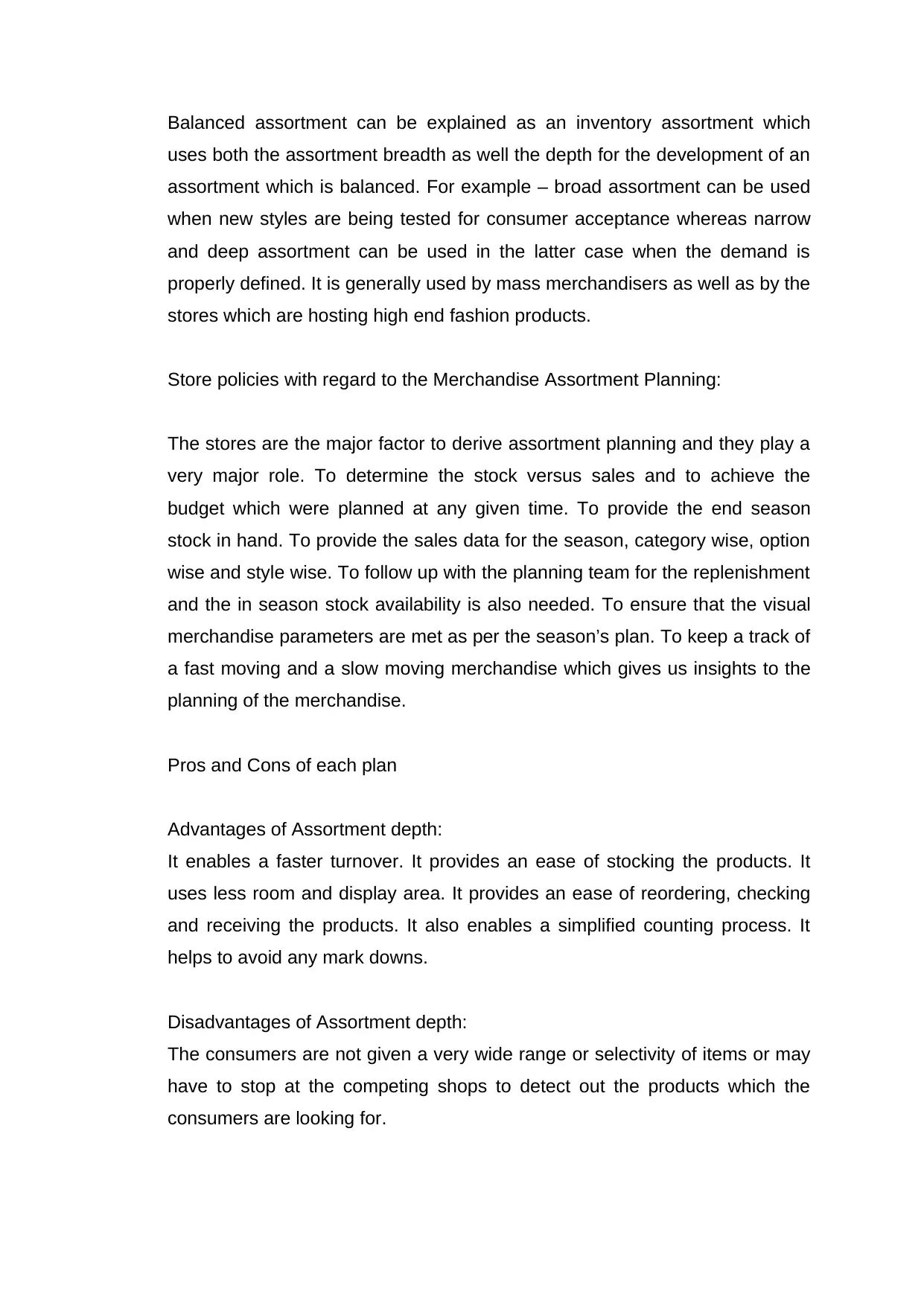
Balanced assortment can be explained as an inventory assortment which
uses both the assortment breadth as well the depth for the development of an
assortment which is balanced. For example – broad assortment can be used
when new styles are being tested for consumer acceptance whereas narrow
and deep assortment can be used in the latter case when the demand is
properly defined. It is generally used by mass merchandisers as well as by the
stores which are hosting high end fashion products.
Store policies with regard to the Merchandise Assortment Planning:
The stores are the major factor to derive assortment planning and they play a
very major role. To determine the stock versus sales and to achieve the
budget which were planned at any given time. To provide the end season
stock in hand. To provide the sales data for the season, category wise, option
wise and style wise. To follow up with the planning team for the replenishment
and the in season stock availability is also needed. To ensure that the visual
merchandise parameters are met as per the season’s plan. To keep a track of
a fast moving and a slow moving merchandise which gives us insights to the
planning of the merchandise.
Pros and Cons of each plan
Advantages of Assortment depth:
It enables a faster turnover. It provides an ease of stocking the products. It
uses less room and display area. It provides an ease of reordering, checking
and receiving the products. It also enables a simplified counting process. It
helps to avoid any mark downs.
Disadvantages of Assortment depth:
The consumers are not given a very wide range or selectivity of items or may
have to stop at the competing shops to detect out the products which the
consumers are looking for.
uses both the assortment breadth as well the depth for the development of an
assortment which is balanced. For example – broad assortment can be used
when new styles are being tested for consumer acceptance whereas narrow
and deep assortment can be used in the latter case when the demand is
properly defined. It is generally used by mass merchandisers as well as by the
stores which are hosting high end fashion products.
Store policies with regard to the Merchandise Assortment Planning:
The stores are the major factor to derive assortment planning and they play a
very major role. To determine the stock versus sales and to achieve the
budget which were planned at any given time. To provide the end season
stock in hand. To provide the sales data for the season, category wise, option
wise and style wise. To follow up with the planning team for the replenishment
and the in season stock availability is also needed. To ensure that the visual
merchandise parameters are met as per the season’s plan. To keep a track of
a fast moving and a slow moving merchandise which gives us insights to the
planning of the merchandise.
Pros and Cons of each plan
Advantages of Assortment depth:
It enables a faster turnover. It provides an ease of stocking the products. It
uses less room and display area. It provides an ease of reordering, checking
and receiving the products. It also enables a simplified counting process. It
helps to avoid any mark downs.
Disadvantages of Assortment depth:
The consumers are not given a very wide range or selectivity of items or may
have to stop at the competing shops to detect out the products which the
consumers are looking for.
⊘ This is a preview!⊘
Do you want full access?
Subscribe today to unlock all pages.

Trusted by 1+ million students worldwide
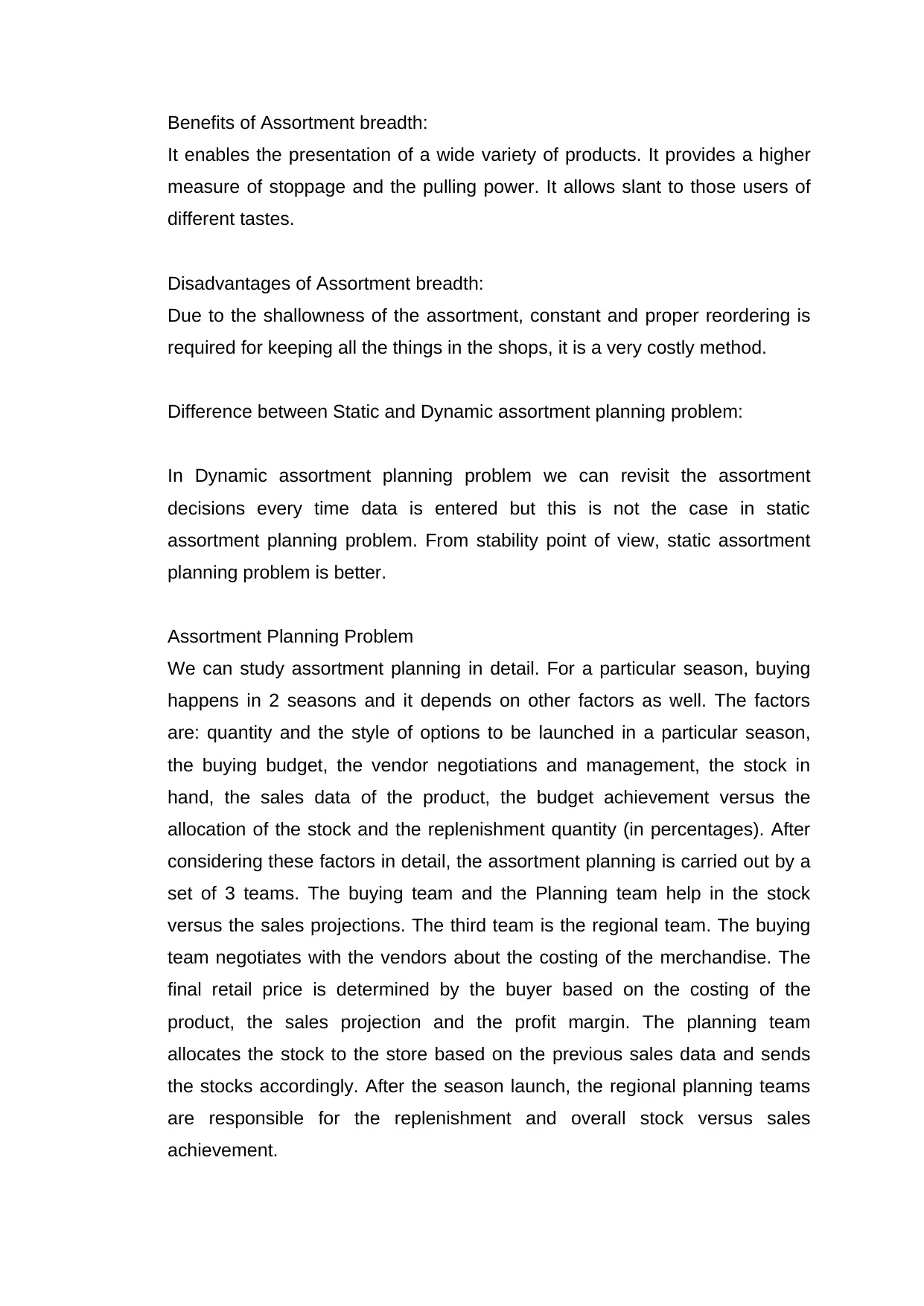
Benefits of Assortment breadth:
It enables the presentation of a wide variety of products. It provides a higher
measure of stoppage and the pulling power. It allows slant to those users of
different tastes.
Disadvantages of Assortment breadth:
Due to the shallowness of the assortment, constant and proper reordering is
required for keeping all the things in the shops, it is a very costly method.
Difference between Static and Dynamic assortment planning problem:
In Dynamic assortment planning problem we can revisit the assortment
decisions every time data is entered but this is not the case in static
assortment planning problem. From stability point of view, static assortment
planning problem is better.
Assortment Planning Problem
We can study assortment planning in detail. For a particular season, buying
happens in 2 seasons and it depends on other factors as well. The factors
are: quantity and the style of options to be launched in a particular season,
the buying budget, the vendor negotiations and management, the stock in
hand, the sales data of the product, the budget achievement versus the
allocation of the stock and the replenishment quantity (in percentages). After
considering these factors in detail, the assortment planning is carried out by a
set of 3 teams. The buying team and the Planning team help in the stock
versus the sales projections. The third team is the regional team. The buying
team negotiates with the vendors about the costing of the merchandise. The
final retail price is determined by the buyer based on the costing of the
product, the sales projection and the profit margin. The planning team
allocates the stock to the store based on the previous sales data and sends
the stocks accordingly. After the season launch, the regional planning teams
are responsible for the replenishment and overall stock versus sales
achievement.
It enables the presentation of a wide variety of products. It provides a higher
measure of stoppage and the pulling power. It allows slant to those users of
different tastes.
Disadvantages of Assortment breadth:
Due to the shallowness of the assortment, constant and proper reordering is
required for keeping all the things in the shops, it is a very costly method.
Difference between Static and Dynamic assortment planning problem:
In Dynamic assortment planning problem we can revisit the assortment
decisions every time data is entered but this is not the case in static
assortment planning problem. From stability point of view, static assortment
planning problem is better.
Assortment Planning Problem
We can study assortment planning in detail. For a particular season, buying
happens in 2 seasons and it depends on other factors as well. The factors
are: quantity and the style of options to be launched in a particular season,
the buying budget, the vendor negotiations and management, the stock in
hand, the sales data of the product, the budget achievement versus the
allocation of the stock and the replenishment quantity (in percentages). After
considering these factors in detail, the assortment planning is carried out by a
set of 3 teams. The buying team and the Planning team help in the stock
versus the sales projections. The third team is the regional team. The buying
team negotiates with the vendors about the costing of the merchandise. The
final retail price is determined by the buyer based on the costing of the
product, the sales projection and the profit margin. The planning team
allocates the stock to the store based on the previous sales data and sends
the stocks accordingly. After the season launch, the regional planning teams
are responsible for the replenishment and overall stock versus sales
achievement.
Paraphrase This Document
Need a fresh take? Get an instant paraphrase of this document with our AI Paraphraser
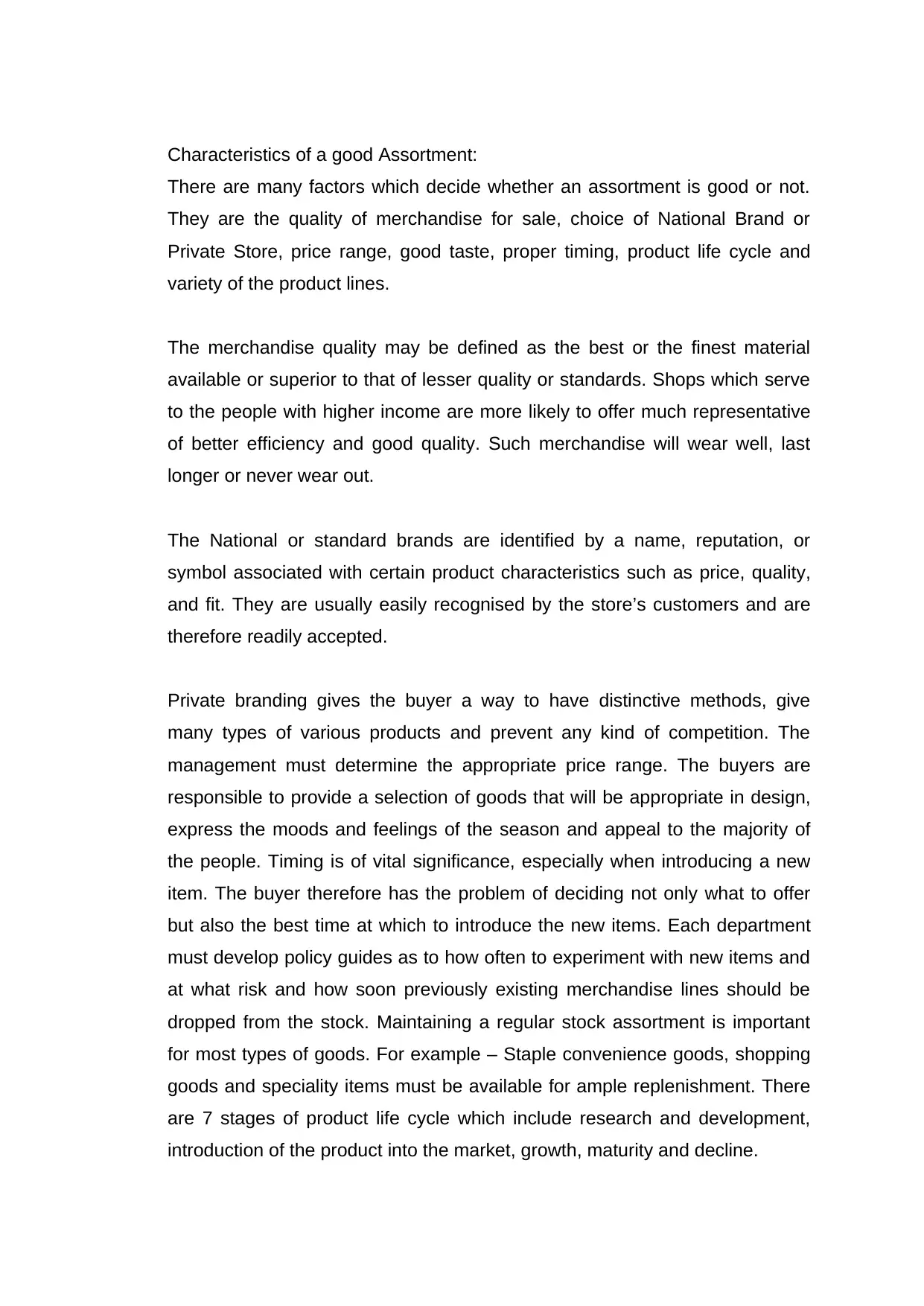
Characteristics of a good Assortment:
There are many factors which decide whether an assortment is good or not.
They are the quality of merchandise for sale, choice of National Brand or
Private Store, price range, good taste, proper timing, product life cycle and
variety of the product lines.
The merchandise quality may be defined as the best or the finest material
available or superior to that of lesser quality or standards. Shops which serve
to the people with higher income are more likely to offer much representative
of better efficiency and good quality. Such merchandise will wear well, last
longer or never wear out.
The National or standard brands are identified by a name, reputation, or
symbol associated with certain product characteristics such as price, quality,
and fit. They are usually easily recognised by the store’s customers and are
therefore readily accepted.
Private branding gives the buyer a way to have distinctive methods, give
many types of various products and prevent any kind of competition. The
management must determine the appropriate price range. The buyers are
responsible to provide a selection of goods that will be appropriate in design,
express the moods and feelings of the season and appeal to the majority of
the people. Timing is of vital significance, especially when introducing a new
item. The buyer therefore has the problem of deciding not only what to offer
but also the best time at which to introduce the new items. Each department
must develop policy guides as to how often to experiment with new items and
at what risk and how soon previously existing merchandise lines should be
dropped from the stock. Maintaining a regular stock assortment is important
for most types of goods. For example – Staple convenience goods, shopping
goods and speciality items must be available for ample replenishment. There
are 7 stages of product life cycle which include research and development,
introduction of the product into the market, growth, maturity and decline.
There are many factors which decide whether an assortment is good or not.
They are the quality of merchandise for sale, choice of National Brand or
Private Store, price range, good taste, proper timing, product life cycle and
variety of the product lines.
The merchandise quality may be defined as the best or the finest material
available or superior to that of lesser quality or standards. Shops which serve
to the people with higher income are more likely to offer much representative
of better efficiency and good quality. Such merchandise will wear well, last
longer or never wear out.
The National or standard brands are identified by a name, reputation, or
symbol associated with certain product characteristics such as price, quality,
and fit. They are usually easily recognised by the store’s customers and are
therefore readily accepted.
Private branding gives the buyer a way to have distinctive methods, give
many types of various products and prevent any kind of competition. The
management must determine the appropriate price range. The buyers are
responsible to provide a selection of goods that will be appropriate in design,
express the moods and feelings of the season and appeal to the majority of
the people. Timing is of vital significance, especially when introducing a new
item. The buyer therefore has the problem of deciding not only what to offer
but also the best time at which to introduce the new items. Each department
must develop policy guides as to how often to experiment with new items and
at what risk and how soon previously existing merchandise lines should be
dropped from the stock. Maintaining a regular stock assortment is important
for most types of goods. For example – Staple convenience goods, shopping
goods and speciality items must be available for ample replenishment. There
are 7 stages of product life cycle which include research and development,
introduction of the product into the market, growth, maturity and decline.
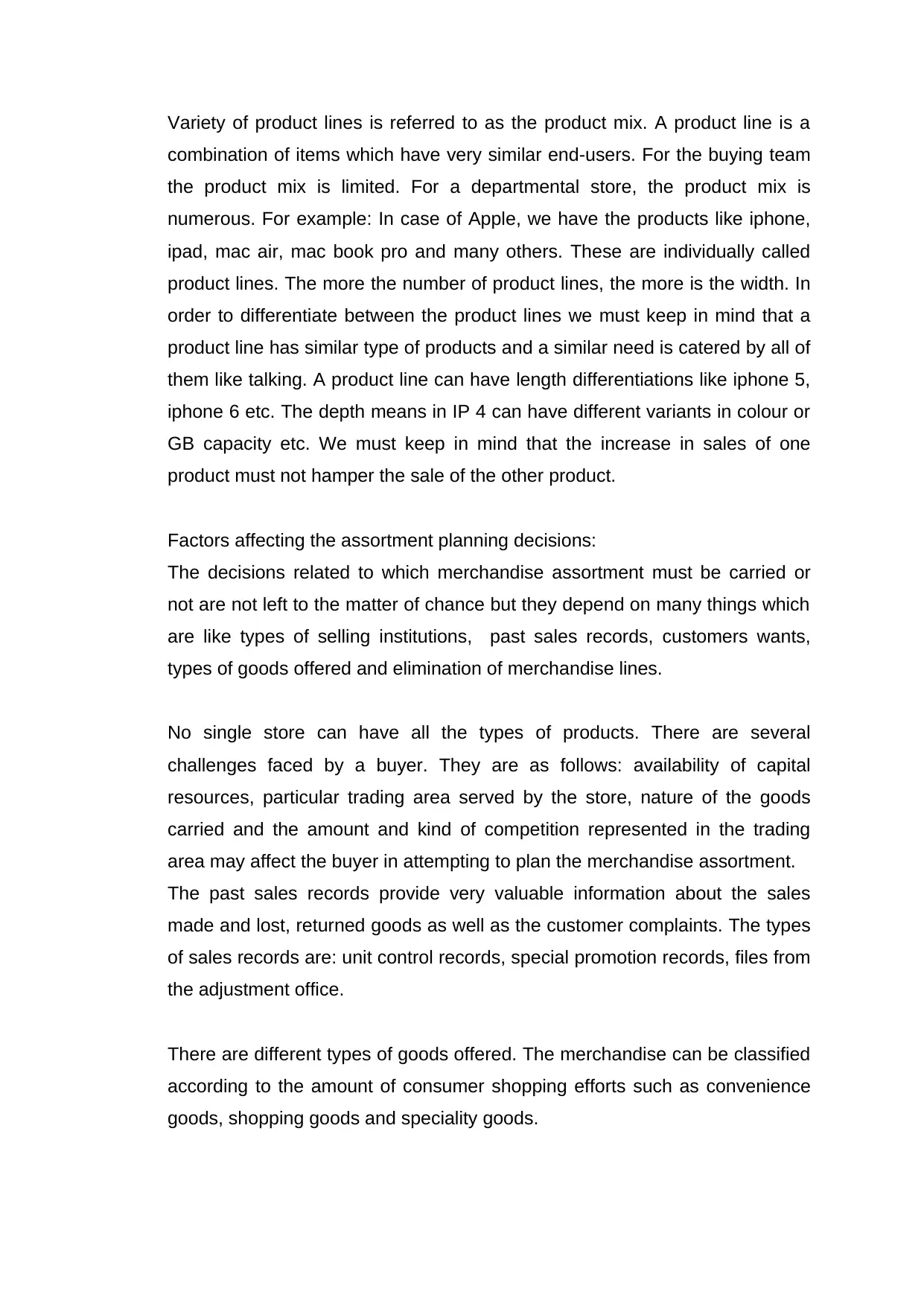
Variety of product lines is referred to as the product mix. A product line is a
combination of items which have very similar end-users. For the buying team
the product mix is limited. For a departmental store, the product mix is
numerous. For example: In case of Apple, we have the products like iphone,
ipad, mac air, mac book pro and many others. These are individually called
product lines. The more the number of product lines, the more is the width. In
order to differentiate between the product lines we must keep in mind that a
product line has similar type of products and a similar need is catered by all of
them like talking. A product line can have length differentiations like iphone 5,
iphone 6 etc. The depth means in IP 4 can have different variants in colour or
GB capacity etc. We must keep in mind that the increase in sales of one
product must not hamper the sale of the other product.
Factors affecting the assortment planning decisions:
The decisions related to which merchandise assortment must be carried or
not are not left to the matter of chance but they depend on many things which
are like types of selling institutions, past sales records, customers wants,
types of goods offered and elimination of merchandise lines.
No single store can have all the types of products. There are several
challenges faced by a buyer. They are as follows: availability of capital
resources, particular trading area served by the store, nature of the goods
carried and the amount and kind of competition represented in the trading
area may affect the buyer in attempting to plan the merchandise assortment.
The past sales records provide very valuable information about the sales
made and lost, returned goods as well as the customer complaints. The types
of sales records are: unit control records, special promotion records, files from
the adjustment office.
There are different types of goods offered. The merchandise can be classified
according to the amount of consumer shopping efforts such as convenience
goods, shopping goods and speciality goods.
combination of items which have very similar end-users. For the buying team
the product mix is limited. For a departmental store, the product mix is
numerous. For example: In case of Apple, we have the products like iphone,
ipad, mac air, mac book pro and many others. These are individually called
product lines. The more the number of product lines, the more is the width. In
order to differentiate between the product lines we must keep in mind that a
product line has similar type of products and a similar need is catered by all of
them like talking. A product line can have length differentiations like iphone 5,
iphone 6 etc. The depth means in IP 4 can have different variants in colour or
GB capacity etc. We must keep in mind that the increase in sales of one
product must not hamper the sale of the other product.
Factors affecting the assortment planning decisions:
The decisions related to which merchandise assortment must be carried or
not are not left to the matter of chance but they depend on many things which
are like types of selling institutions, past sales records, customers wants,
types of goods offered and elimination of merchandise lines.
No single store can have all the types of products. There are several
challenges faced by a buyer. They are as follows: availability of capital
resources, particular trading area served by the store, nature of the goods
carried and the amount and kind of competition represented in the trading
area may affect the buyer in attempting to plan the merchandise assortment.
The past sales records provide very valuable information about the sales
made and lost, returned goods as well as the customer complaints. The types
of sales records are: unit control records, special promotion records, files from
the adjustment office.
There are different types of goods offered. The merchandise can be classified
according to the amount of consumer shopping efforts such as convenience
goods, shopping goods and speciality goods.
⊘ This is a preview!⊘
Do you want full access?
Subscribe today to unlock all pages.

Trusted by 1+ million students worldwide
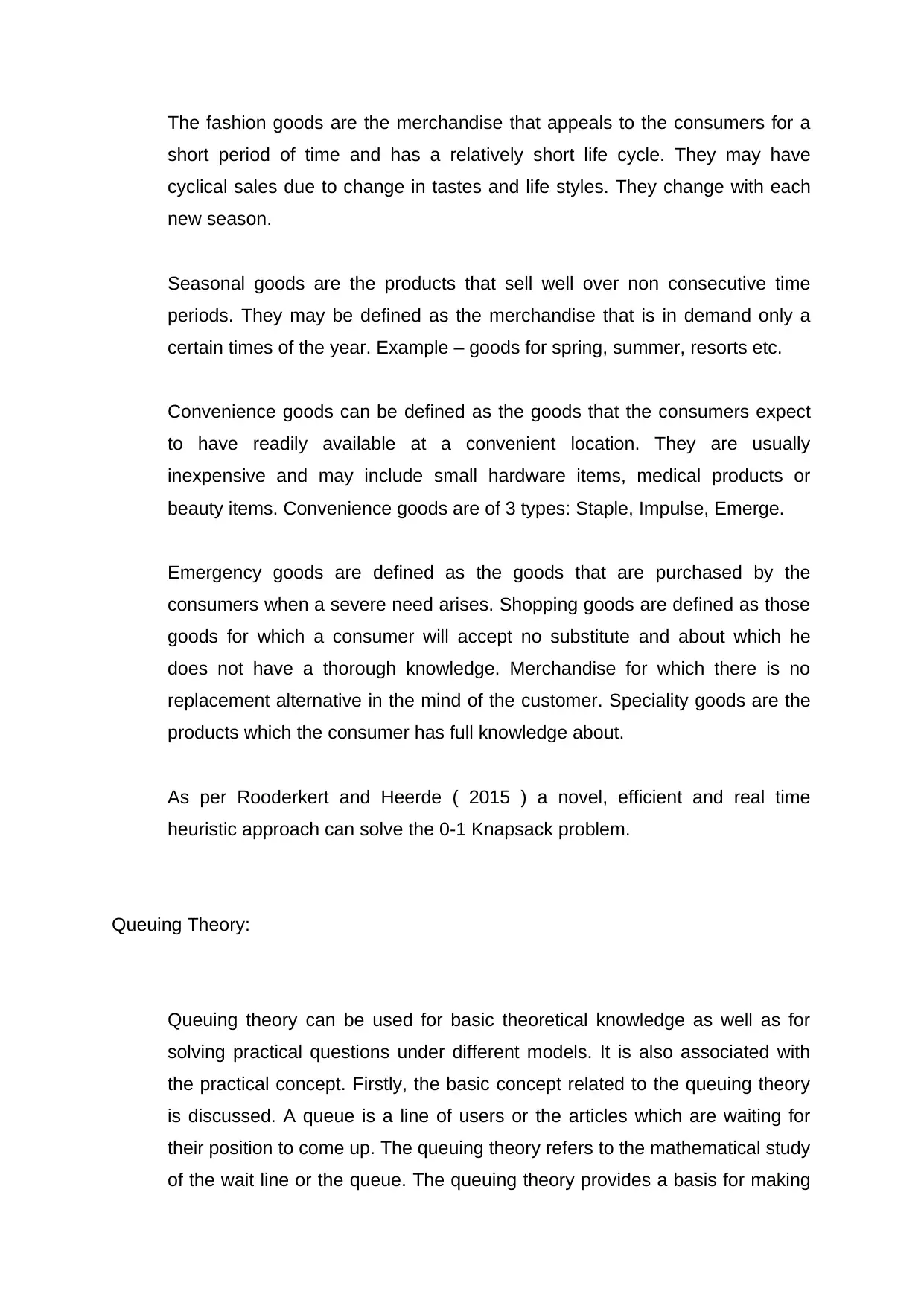
The fashion goods are the merchandise that appeals to the consumers for a
short period of time and has a relatively short life cycle. They may have
cyclical sales due to change in tastes and life styles. They change with each
new season.
Seasonal goods are the products that sell well over non consecutive time
periods. They may be defined as the merchandise that is in demand only a
certain times of the year. Example – goods for spring, summer, resorts etc.
Convenience goods can be defined as the goods that the consumers expect
to have readily available at a convenient location. They are usually
inexpensive and may include small hardware items, medical products or
beauty items. Convenience goods are of 3 types: Staple, Impulse, Emerge.
Emergency goods are defined as the goods that are purchased by the
consumers when a severe need arises. Shopping goods are defined as those
goods for which a consumer will accept no substitute and about which he
does not have a thorough knowledge. Merchandise for which there is no
replacement alternative in the mind of the customer. Speciality goods are the
products which the consumer has full knowledge about.
As per Rooderkert and Heerde ( 2015 ) a novel, efficient and real time
heuristic approach can solve the 0-1 Knapsack problem.
Queuing Theory:
Queuing theory can be used for basic theoretical knowledge as well as for
solving practical questions under different models. It is also associated with
the practical concept. Firstly, the basic concept related to the queuing theory
is discussed. A queue is a line of users or the articles which are waiting for
their position to come up. The queuing theory refers to the mathematical study
of the wait line or the queue. The queuing theory provides a basis for making
short period of time and has a relatively short life cycle. They may have
cyclical sales due to change in tastes and life styles. They change with each
new season.
Seasonal goods are the products that sell well over non consecutive time
periods. They may be defined as the merchandise that is in demand only a
certain times of the year. Example – goods for spring, summer, resorts etc.
Convenience goods can be defined as the goods that the consumers expect
to have readily available at a convenient location. They are usually
inexpensive and may include small hardware items, medical products or
beauty items. Convenience goods are of 3 types: Staple, Impulse, Emerge.
Emergency goods are defined as the goods that are purchased by the
consumers when a severe need arises. Shopping goods are defined as those
goods for which a consumer will accept no substitute and about which he
does not have a thorough knowledge. Merchandise for which there is no
replacement alternative in the mind of the customer. Speciality goods are the
products which the consumer has full knowledge about.
As per Rooderkert and Heerde ( 2015 ) a novel, efficient and real time
heuristic approach can solve the 0-1 Knapsack problem.
Queuing Theory:
Queuing theory can be used for basic theoretical knowledge as well as for
solving practical questions under different models. It is also associated with
the practical concept. Firstly, the basic concept related to the queuing theory
is discussed. A queue is a line of users or the articles which are waiting for
their position to come up. The queuing theory refers to the mathematical study
of the wait line or the queue. The queuing theory provides a basis for making
Paraphrase This Document
Need a fresh take? Get an instant paraphrase of this document with our AI Paraphraser
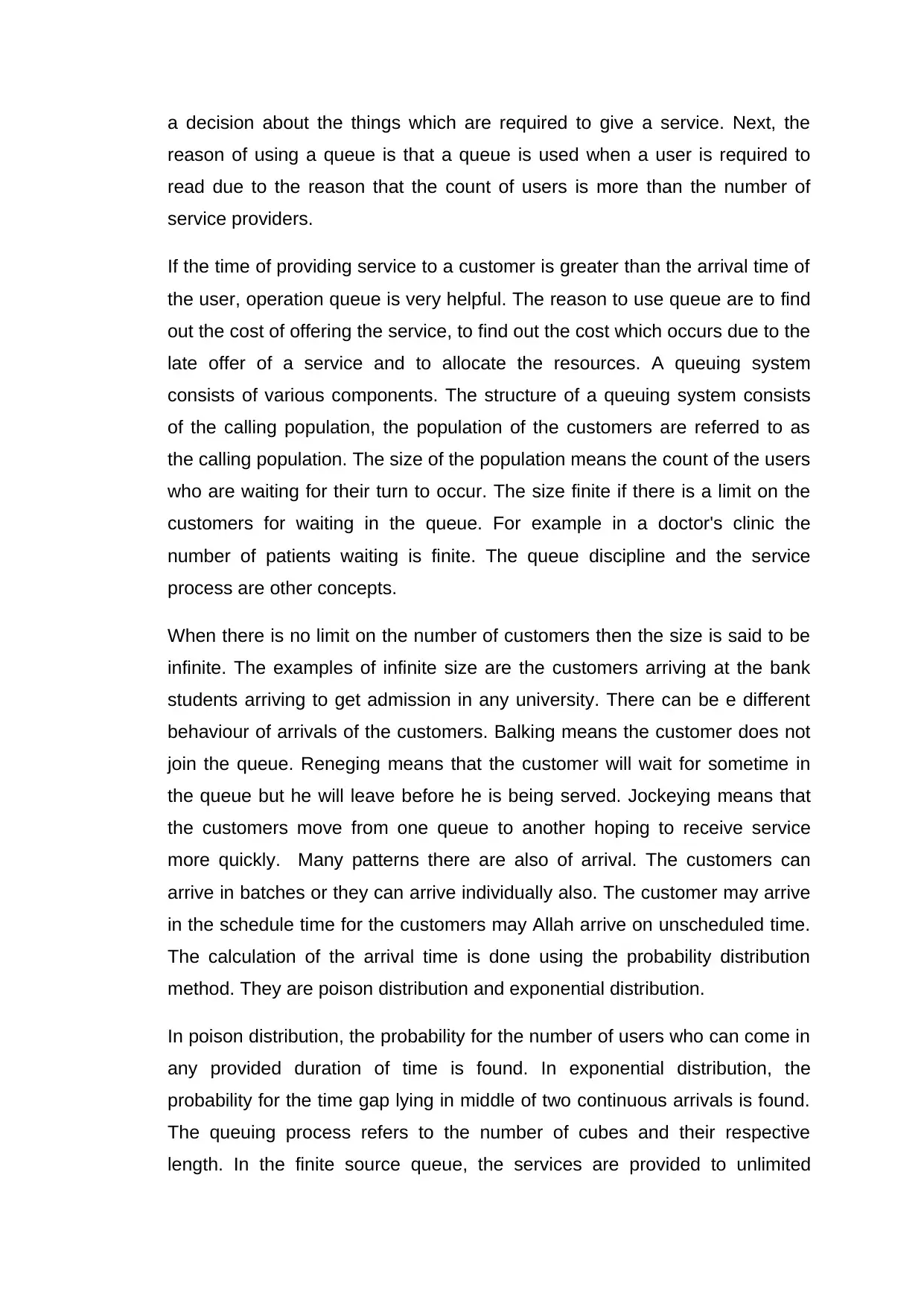
a decision about the things which are required to give a service. Next, the
reason of using a queue is that a queue is used when a user is required to
read due to the reason that the count of users is more than the number of
service providers.
If the time of providing service to a customer is greater than the arrival time of
the user, operation queue is very helpful. The reason to use queue are to find
out the cost of offering the service, to find out the cost which occurs due to the
late offer of a service and to allocate the resources. A queuing system
consists of various components. The structure of a queuing system consists
of the calling population, the population of the customers are referred to as
the calling population. The size of the population means the count of the users
who are waiting for their turn to occur. The size finite if there is a limit on the
customers for waiting in the queue. For example in a doctor's clinic the
number of patients waiting is finite. The queue discipline and the service
process are other concepts.
When there is no limit on the number of customers then the size is said to be
infinite. The examples of infinite size are the customers arriving at the bank
students arriving to get admission in any university. There can be e different
behaviour of arrivals of the customers. Balking means the customer does not
join the queue. Reneging means that the customer will wait for sometime in
the queue but he will leave before he is being served. Jockeying means that
the customers move from one queue to another hoping to receive service
more quickly. Many patterns there are also of arrival. The customers can
arrive in batches or they can arrive individually also. The customer may arrive
in the schedule time for the customers may Allah arrive on unscheduled time.
The calculation of the arrival time is done using the probability distribution
method. They are poison distribution and exponential distribution.
In poison distribution, the probability for the number of users who can come in
any provided duration of time is found. In exponential distribution, the
probability for the time gap lying in middle of two continuous arrivals is found.
The queuing process refers to the number of cubes and their respective
length. In the finite source queue, the services are provided to unlimited
reason of using a queue is that a queue is used when a user is required to
read due to the reason that the count of users is more than the number of
service providers.
If the time of providing service to a customer is greater than the arrival time of
the user, operation queue is very helpful. The reason to use queue are to find
out the cost of offering the service, to find out the cost which occurs due to the
late offer of a service and to allocate the resources. A queuing system
consists of various components. The structure of a queuing system consists
of the calling population, the population of the customers are referred to as
the calling population. The size of the population means the count of the users
who are waiting for their turn to occur. The size finite if there is a limit on the
customers for waiting in the queue. For example in a doctor's clinic the
number of patients waiting is finite. The queue discipline and the service
process are other concepts.
When there is no limit on the number of customers then the size is said to be
infinite. The examples of infinite size are the customers arriving at the bank
students arriving to get admission in any university. There can be e different
behaviour of arrivals of the customers. Balking means the customer does not
join the queue. Reneging means that the customer will wait for sometime in
the queue but he will leave before he is being served. Jockeying means that
the customers move from one queue to another hoping to receive service
more quickly. Many patterns there are also of arrival. The customers can
arrive in batches or they can arrive individually also. The customer may arrive
in the schedule time for the customers may Allah arrive on unscheduled time.
The calculation of the arrival time is done using the probability distribution
method. They are poison distribution and exponential distribution.
In poison distribution, the probability for the number of users who can come in
any provided duration of time is found. In exponential distribution, the
probability for the time gap lying in middle of two continuous arrivals is found.
The queuing process refers to the number of cubes and their respective
length. In the finite source queue, the services are provided to unlimited
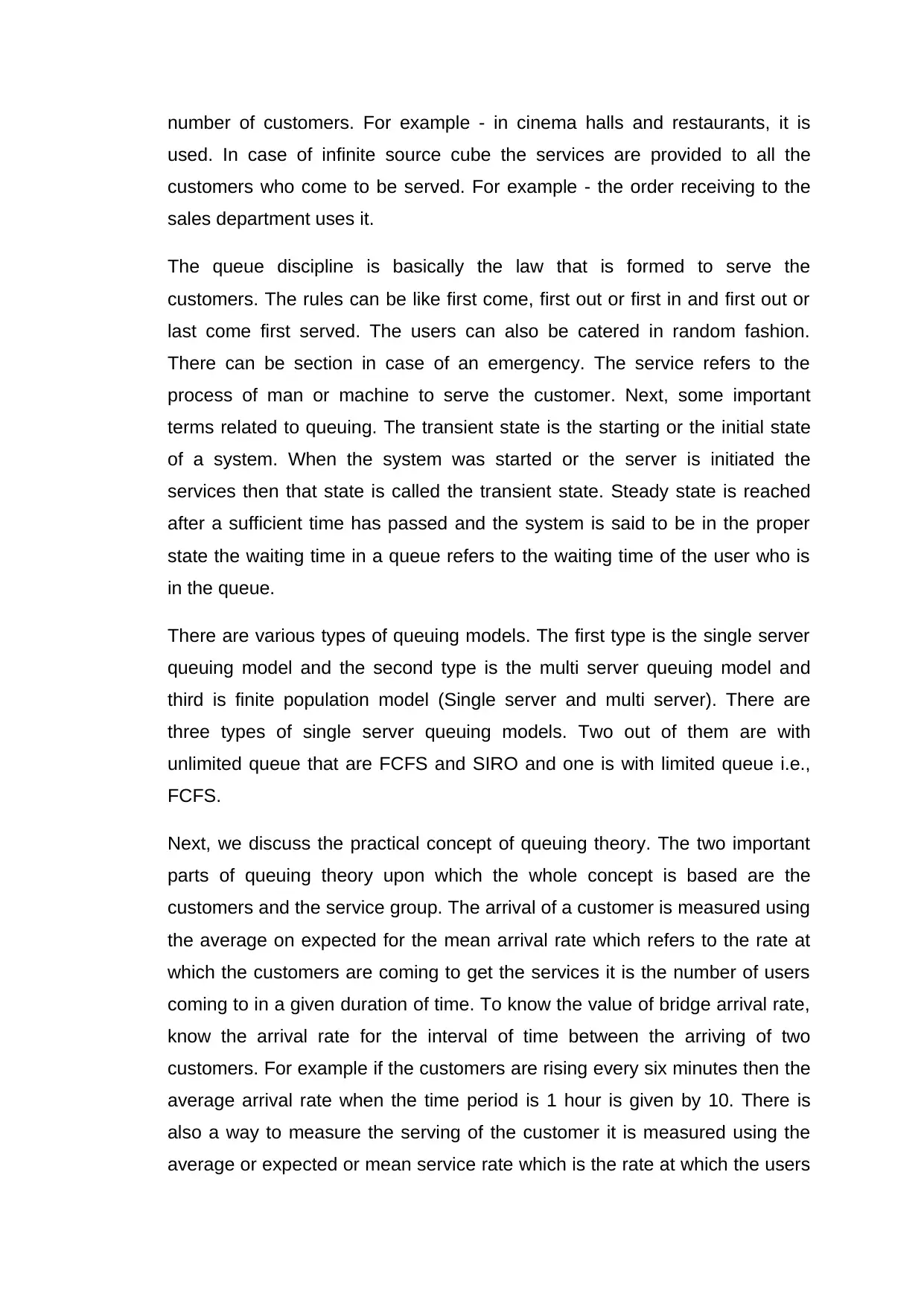
number of customers. For example - in cinema halls and restaurants, it is
used. In case of infinite source cube the services are provided to all the
customers who come to be served. For example - the order receiving to the
sales department uses it.
The queue discipline is basically the law that is formed to serve the
customers. The rules can be like first come, first out or first in and first out or
last come first served. The users can also be catered in random fashion.
There can be section in case of an emergency. The service refers to the
process of man or machine to serve the customer. Next, some important
terms related to queuing. The transient state is the starting or the initial state
of a system. When the system was started or the server is initiated the
services then that state is called the transient state. Steady state is reached
after a sufficient time has passed and the system is said to be in the proper
state the waiting time in a queue refers to the waiting time of the user who is
in the queue.
There are various types of queuing models. The first type is the single server
queuing model and the second type is the multi server queuing model and
third is finite population model (Single server and multi server). There are
three types of single server queuing models. Two out of them are with
unlimited queue that are FCFS and SIRO and one is with limited queue i.e.,
FCFS.
Next, we discuss the practical concept of queuing theory. The two important
parts of queuing theory upon which the whole concept is based are the
customers and the service group. The arrival of a customer is measured using
the average on expected for the mean arrival rate which refers to the rate at
which the customers are coming to get the services it is the number of users
coming to in a given duration of time. To know the value of bridge arrival rate,
know the arrival rate for the interval of time between the arriving of two
customers. For example if the customers are rising every six minutes then the
average arrival rate when the time period is 1 hour is given by 10. There is
also a way to measure the serving of the customer it is measured using the
average or expected or mean service rate which is the rate at which the users
used. In case of infinite source cube the services are provided to all the
customers who come to be served. For example - the order receiving to the
sales department uses it.
The queue discipline is basically the law that is formed to serve the
customers. The rules can be like first come, first out or first in and first out or
last come first served. The users can also be catered in random fashion.
There can be section in case of an emergency. The service refers to the
process of man or machine to serve the customer. Next, some important
terms related to queuing. The transient state is the starting or the initial state
of a system. When the system was started or the server is initiated the
services then that state is called the transient state. Steady state is reached
after a sufficient time has passed and the system is said to be in the proper
state the waiting time in a queue refers to the waiting time of the user who is
in the queue.
There are various types of queuing models. The first type is the single server
queuing model and the second type is the multi server queuing model and
third is finite population model (Single server and multi server). There are
three types of single server queuing models. Two out of them are with
unlimited queue that are FCFS and SIRO and one is with limited queue i.e.,
FCFS.
Next, we discuss the practical concept of queuing theory. The two important
parts of queuing theory upon which the whole concept is based are the
customers and the service group. The arrival of a customer is measured using
the average on expected for the mean arrival rate which refers to the rate at
which the customers are coming to get the services it is the number of users
coming to in a given duration of time. To know the value of bridge arrival rate,
know the arrival rate for the interval of time between the arriving of two
customers. For example if the customers are rising every six minutes then the
average arrival rate when the time period is 1 hour is given by 10. There is
also a way to measure the serving of the customer it is measured using the
average or expected or mean service rate which is the rate at which the users
⊘ This is a preview!⊘
Do you want full access?
Subscribe today to unlock all pages.

Trusted by 1+ million students worldwide
1 out of 18
Your All-in-One AI-Powered Toolkit for Academic Success.
+13062052269
info@desklib.com
Available 24*7 on WhatsApp / Email
![[object Object]](/_next/static/media/star-bottom.7253800d.svg)
Unlock your academic potential
Copyright © 2020–2025 A2Z Services. All Rights Reserved. Developed and managed by ZUCOL.